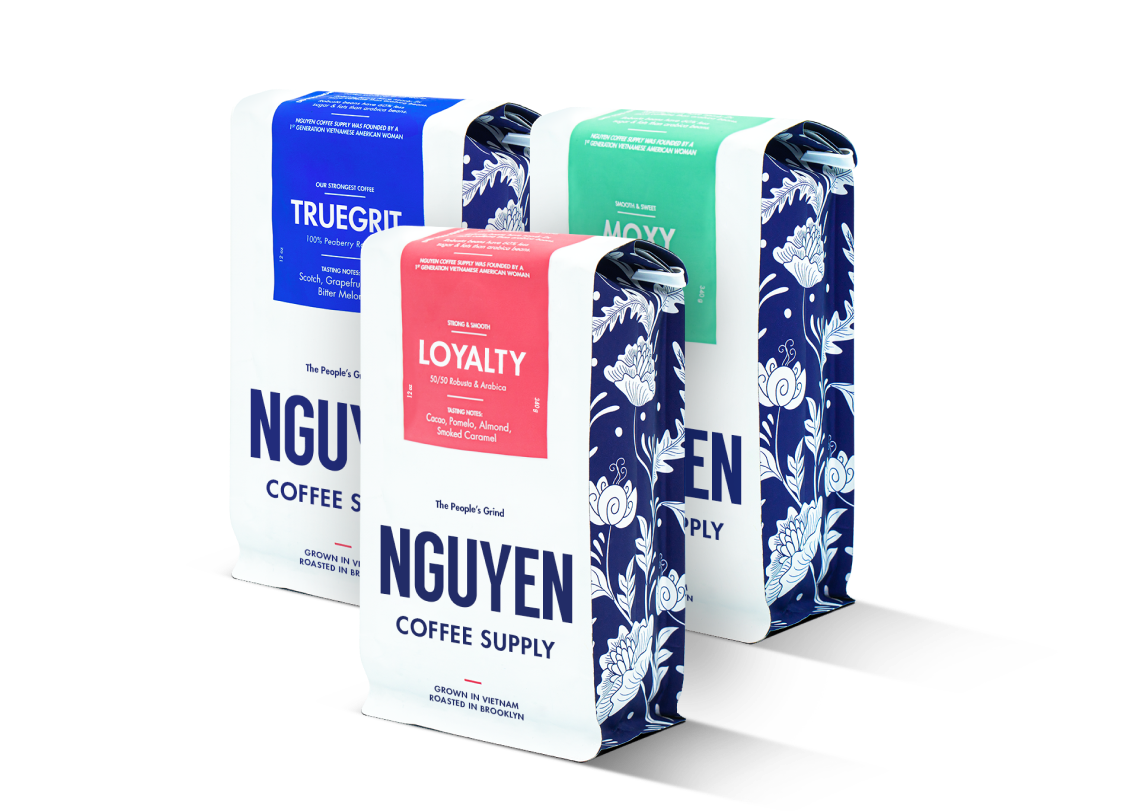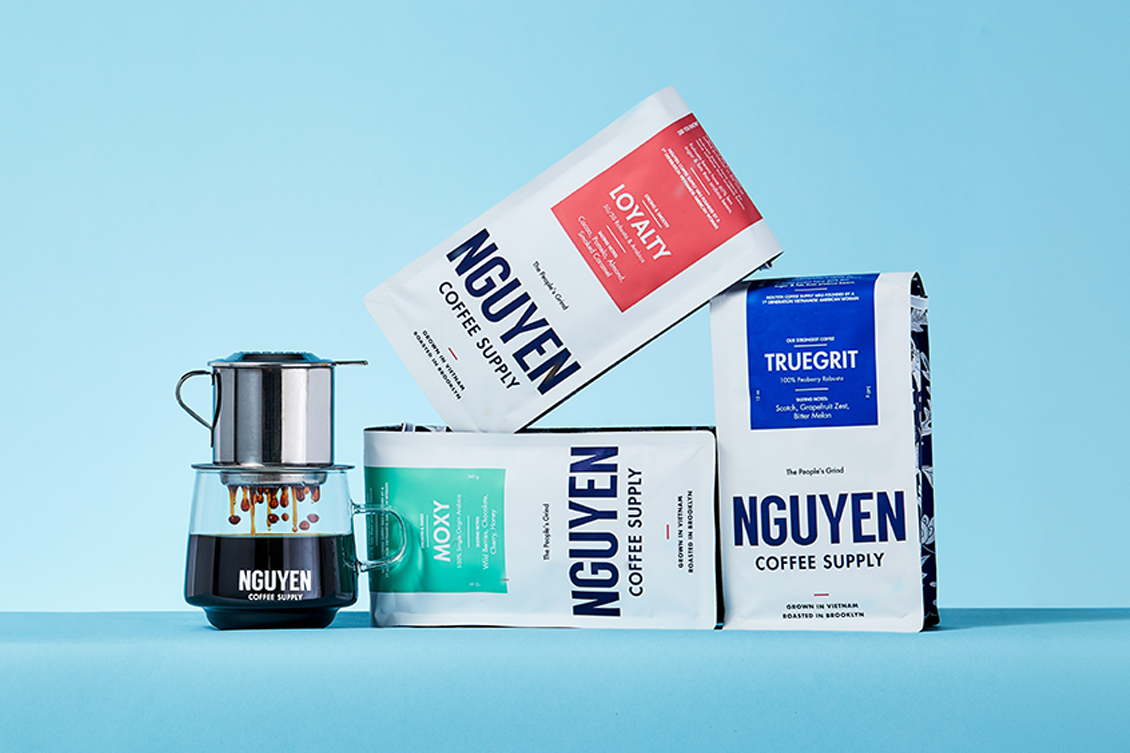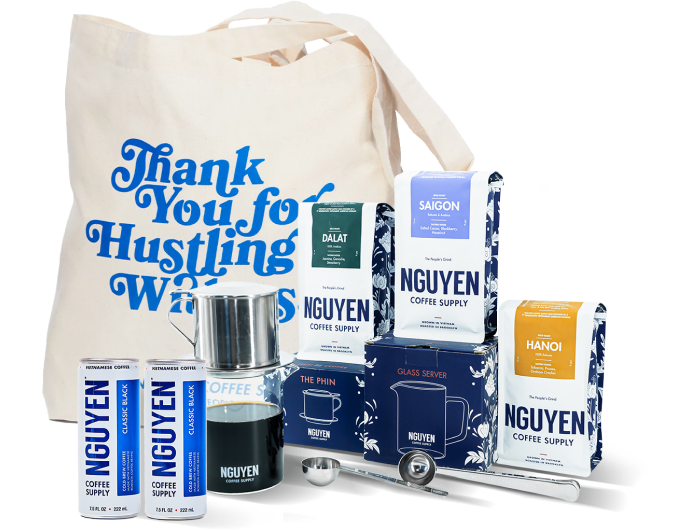

- FAN FAVORITE

Create for yourself or as a gift for your loved ones
Subscribe nowMe and mom just enjoyed the Nguyen phin drip experience. Wow. Proud of your work. We without hesitation enjoy the Vietnamese coffee and recommend your products. Thank-you to the Nguyen staff and tradition. From Canada eh!
The idea behind Vietnamese Egg Coffee (cà phê trứng) is quite simple: instead of using regular milk to get that creamy and thick consistency, raw egg yolk is added. This, combined with condensed milk, makes for a coffee beverage that is very complex in flavor and has a thick consistency that has made it popular all around the world.
One of the charms of Vietnamese egg coffee is that it is quite customizable. Different cafés have different “topping” options, where the customer can choose extra ingredients to add to their coffee. These range from the most typical of coffee pairings such as spices to other more unusual ones, like butter and cheese.
Whatever the case, Vietnamese egg coffee is a delicious drink that has captivated the imaginations of countless baristas worldwide, driving them to imitate and put their own spin on the drink. In this article, you’ll get to know the history of just how this drink came to be as well as a couple of recipes for you to make it at home.
It is 1946 in Hanoi, Vietnam, and the Anti-French Resistance war breaks out. Big cities find it increasingly difficult to procure basic products and foods. This is the case for the Sofitel Legend Metropole Hotel (which still operates to this day as a five-star luxury hotel), which is rapidly running out of milk.
An ingenious bartender, Nguyen Giang, experiments to find a way to create a creamy coffee drink like café au lait that could be achieved without the lait. This leads him to use egg yolk, which is creamy and when frothed, creates a delicate, pleasant foam. To his surprise, the flavor of egg yolk agrees with coffee and the sweetness of condensed milk, a product widely used in Vietnam along with foods like yogurt, bread, smoothies, and even iced coffee (cà phê sữa đá).
The drink was so popular that Nguyen Giang eventually opened his own coffee shop: Café Giang. Run by Nguyen Giang’s son, Tri Hoa Nguyen, the cafe still serves egg coffee (with their own original spin, a secret ingredient they won’t disclose to the public) and is one of the most famous coffee spots in Hanoi.
There are several coffee drinks that have originated in Vietnam. There is cà phê sữa đá, which is typically referred to as Vietnamese iced coffee. It is made by mixing coffee with condensed milk and then adding ice (although this is optional).
There is also coconut coffee, cà phê cốt dừa, which uses coconut milk as well as condensed milk. The result is a rich and fragrant drink. It has a unique, sweet flavor that is hard to resist.
Even in the face of such unique and internationally liked drinks, egg coffee or cà phê trứng stands out as the most original of all. Egg yolk adds a depth of flavor and texture that is very hard to match. Egg in coffee– and egg yolk in particular– has a long history of being used for sweet foods and beverages: sweet egg yolk buns in China, tamagoyaki (sweet egg omelette) in Japan, and eggnog in the United Kingdom.
Additionally, there’s a lot to be said about the higher nutritional value of Vietnamese egg coffee because of the protein and healthy fats that are found in the egg yolk. After all, eggs are said to be the most complete of all protein sources.
One could argue that Vietnamese egg coffee is a type of beverage that is deeply rooted in the country’s unique culture. For one, Vietnamese egg coffee is typically made and will taste better when robusta coffee is used– as it’s strong, rich flavor pairs particularly well with the flavor and texture of egg yolk.
The importance of robusta coffee in Vietnam cannot be overstated. Vietnam is the second-largest coffee exporter in the world exporting mostly robusta beans. Robusta beans, while often relegated to a supporting role in Europe and North America (for instant coffee and such) are still of great value to all coffee drinkers. Robusta coffee plays a very important role in Vietnamese economy and culture– Vietnamese people are very proud of their coffee and are big drinkers of their own product, rather than drinking imported coffee (although there are several Starbucks shops in Hanoi and Ho Chi Minh City).
Condensed milk, another crucial ingredient, is another staple of Vietnamese people’s diet and has been for almost a century. It was brought over from France during the First World War, and Vietnamese people took a liking to it. It is an everyday ingredient much like milk is for other cultures.
It is also important to point out that Vietnam is home to their own indigenous brewing method, the Vietnamese phin filter. It is the only country East of Europe to be able to boast this besides Japan. The Vietnamese phin filter (or coffee press as some call it) makes a concentrated coffee that is often likened to espresso coffee– it is strong, fragrant, and very refined in terms of flavor.
Nguyen Giang made coffee using egg yolk, that much is clear. What is not clear is what type of coffee was used.
Since the Sofitel Legend Metropole Hotel was a luxury at the time and catered heavily to foreigners, it is ambiguous whether the coffee was brewed using a Vietnamese phin filter or via another method. Semi-automatic espresso machines weren’t invented for another year, so it's safe to assume that it wasn’t espresso. In all likelihood, it was either French press coffee or Vietnamese phin filter coffee.
While you don’t necessarily need a Vietnamese coffee press, it is highly recommended that you use 100% robusta coffee– preferably Vietnamese, the general consensus being that Vietnamese coffee tends to offer a more balanced and more complete flavor profile. But if you can’t find robusta coffee, a strong batch of any other coffee is more than okay for making Vietnamese egg coffee.
Before making egg coffee, we should first learn how to properly brew coffee using a phin filter, the traditional way of brewing coffee in Vietnam. The phin is quite similar to a French press: it’s made of stainless steel and is capable of making very concentrated coffee– perfect for egg coffee.
Before we get into the actual recipe, here’s a quick guide on how to brew coffee using a Vietnamese phin filter:
Robusta beans are recommended (but not necessary) for this coffee.
Grind size: fine, like sand. Use espresso grind.
Ratio: 2 tablespoons of ground coffee (around 14 grams) to 4 oz water
You’ll need:
Instructions:
Now you have a steamy, fragrant cup of Vietnamese coffee ready to use for our next recipe: Vietnamese egg coffee.
Ingredients:
Tools:
Instructions:
For the egg cream:
Assembling the drink:
As for the raw egg yolk, many people express concern at the thought of eating raw egg yolk, even if it’s treated as we just saw in this recipe. The truth is that eating raw egg yolk in your coffee is quite safe– but there are a few tricks you can try if you simply can’t bear the thought of eating raw egg yolk.
The first one is to temper the eggs. Since you’re going to be beating the egg anyway, tempering it won’t affect the end result. Just try not to beat it for too long or it can end up too foamy which isn’t the goal here. You should be aiming for a sweet spot between beating it too little and too much.
The second trick that we can do to cook the eggs while still leaving them creamy is to pasteurize them. Here’s a recipe for making Vietnamese egg coffee but with pasteurized eggs:
Tools:
Ingredients (2 servings):
Instructions:
The reason why robusta is repeatedly recommended for egg coffee is because it has a very distinct nutty flavor profile that really complements the sweet, creamy texture of the egg. Even abroad, in cafés that incorporate this drink to their menus, they use robusta beans because the combination is an explosion of flavor.
Robusta beans should not be hard to find. If you’re having trouble finding 100% robusta products, try looking for blends made for cold brew coffee. These are, in most cases, pure robusta unless they specify otherwise.
Luckily for us, there are plenty of Vietnamese providers nowadays that are able to get you top-notch, authentic Vietnamese coffee, which is ideal for not just Vietnamese egg coffee, but for many other drinks (particularly the aforementioned Vietnamese iced coffee and Vietnamese coconut coffee).
And before you go off and buy the first coffee you find online, be aware that sometimes people confuse chicory-flavored coffee for Vietnamese coffee. This may be because Vietnamese coffee culture was influenced by France– whatever the reason, this sort of coffee is sometimes sold as Vietnamese coffee. Vietnamese coffee is not chicory-flavored, but rather coffee grown in Vietnam.
Learn how to brew other fun coffee drinks using Vietnamese coffee here.